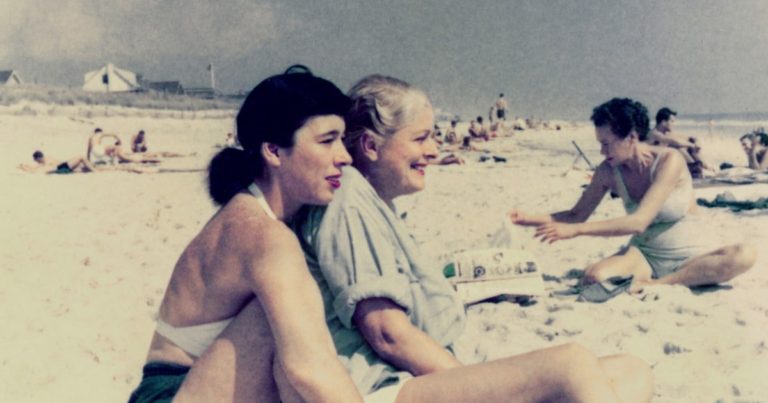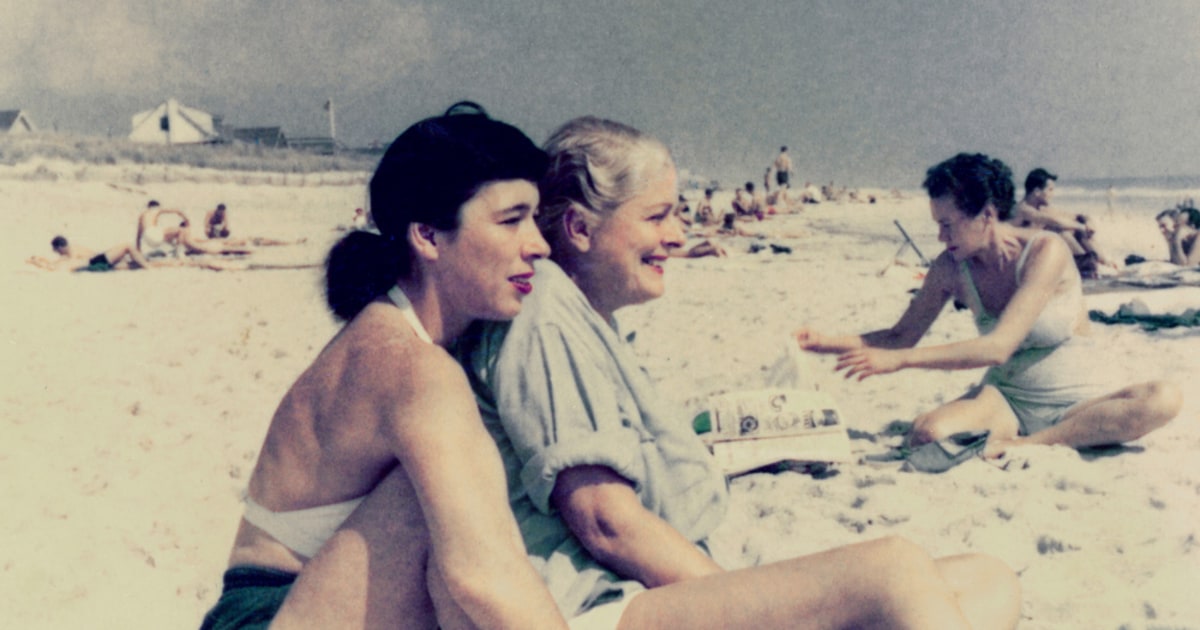

In the summer of 1953, Audrey Hartmann was 23 years old and on vacation with friends. She was staying in Ocean Bay Park, a small beach town on Fire Island, 60 miles from New York City.
She’d heard whispers about a place down the beach called Cherry Grove. A few miles away, it was said to be a welcoming community of gay people. She’d heard there were lesbians there.
Hartmann walked down, and what she saw is on display at a new exhibit at the New-York Historical Society, as well as chronicled in the 1993 book “Cherry Grove, Fire Island: Sixty Years in America’s First Gay and Lesbian Town” by Esther Newton. Hartmann encountered “charming little houses” lit by gas lamps, and wherever she walked were canopies of trees. She caught a glimpse into some of the homes and said, “I remember seeing women by candlelight sitting there,” and wished she was one of them.
Her wish came true. She would go on to live in Cherry Grove and became a beloved member of the community. She and her longtime partner were some of the first women to buy a home on the island. Hartmann, now 90, was interviewed for the exhibit, “Safe/Haven: Gay Life in 1950s Cherry Grove,” which opens Friday at the New-York Historical Society, on Manhattan’s Upper West Side. In a recording, Hartmann says of Cherry Grove, “It was an escape for everyone to be able to come out here on the weekend and be yourself. It was a safe haven. I could say to someone, ‘I’m Audrey Hartmann … and I’m gay.’”
That, at the time, was unheard of.
The exhibit includes 70 photographs and additional ephemera contributed by the Cherry Grove Archives Collection. Included in the exhibit are recorded accounts from notable residents, including Hartmann.
Cherry Grove was one of the first gay beach towns in the United States, joining a handful of LGBTQ vacation spots and resorts that became popular in the pre-Stonewall era, along with places like Provincetown, Massachusetts, and Saugatuck-Douglas, Michigan.
The striking images in the collection are special because of their rarity, as well as the joy and intimacy displayed in them. There is a relaxed nature to the photos, of couples with their arms around each other, friends out at parties or spending time together on the beach.
“Most people didn’t share themselves in that way because they couldn’t be documented. It could be held against them legally,” said Parker Sargent, 46, one of the curators of the exhibit and a representative of the Cherry Grove Archives Collection. In Cherry Grove, gay residents were able to form a community, have a voice in how things were run and be out. “And that’s revolutionary in a really quiet way,” Sergeant said.
Part of what makes Cherry Grove special is its remote location on a barrier island between Long Island and the Atlantic Ocean. Most of the island is only accessible by boat and inaccessible to cars. Cherry Grove provided a sanctuary while also offering queer people the distance and safety required to be themselves, away from the New York laws prohibiting their queer identities and the constant police enforcement of anti-LGBTQ policies.
“Because it’s isolated, people are not judging you, like you’d be afraid of in the real world,” said Susan Kravitz, 77, who curated the exhibit with Sargent and is a committee member of the Cherry Grove archive. “The women in the ‘50s had to wear skirts and dresses … but when they came to Cherry Grove, they could wear trousers — and that was a big deal. Not just pants, but trousers … It’s always about freeing oneself to be who you want to be, and where else can you do that?”
Cherry Grove did have its share of raids and arrests, but the last boat left the island at midnight, meaning there was no police presence once the boat left the dock. That contributed to a vibrant nightlife, one so integral to the community a section of the exhibit is devoted to theater, performance and the social scene. Theater is a lasting legacy of Cherry Grove, as it was theater people who began to vacation there as early as the 1930s, laying a foundation of creativity and openness that has had a lasting draw for the LGBTQ community.
Cherry Grove Archives Collection
Cherry Grove was different from the city, where the gay bars were run by the mob, according to Sargent, who described these urban watering holes as “dark and seedy clubs” where “you always had to be careful that the lights would come on,” signaling a police raid.
“In Cherry Grove, you were suddenly out in nature and sitting on people’s front porches and going to house parties,” Sargent said. “There was a levity and a freedom of not being caught.”
Cherry Grove continued to evolve after the 1950s, moving from a sanctuary for mostly white and affluent gay men and women to a more inclusive place with the advent of the 1960s, as the civil rights movement gained traction and more commercial real estate in the area led to affordable housing options for greater swaths of the community. As the decades move forward, photographs begin to show queer people of color and working-class LGBTQ people.
“You will see such joy in these photographs, you will see happiness, you will see laughter, and you would never think that would be the case given the times in which these people lived,” Kravitz said.
Part of the mission behind “Safe/Haven: Gay Life in 1950s Cherry Grove” is to create an archive where there has been none.
“It’s more than just the photos or the old videos,” Sargent said. “It’s getting that material out there for people to see and to rewrite our history in a way that has been very blank because we tend to think that gay life started at Stonewall. … People have a look at gay history before Stonewall. We’ve always been here.”
Today, Cherry Grove remains a beloved summer destination for LGBTQ beachgoers, particularly lesbians, as has the adjoining community of the Fire Island Pines, which has traditionally catered to gay men. Though the world has become more accepting over the decades, these two Fire Island enclaves remain important to the community, and just as vibrant as ever, welcoming hundreds of thousands of visitors to its boardwalks every season.